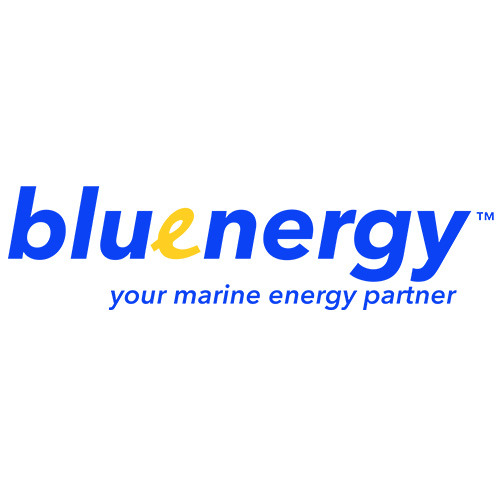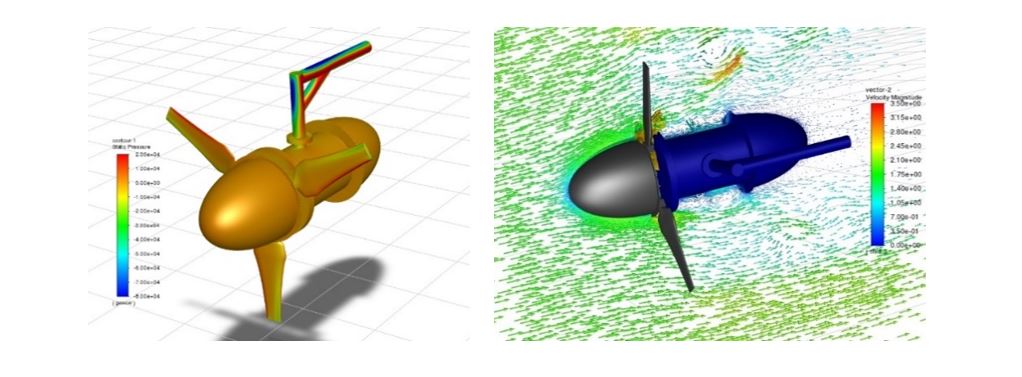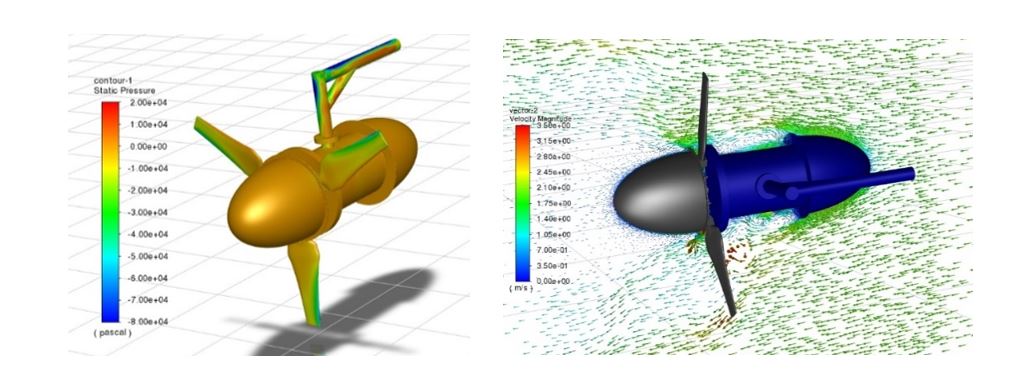CFD Simulation for Sustainable Ocean Energy Products: Tidal Turbine

Collaborator
Bluenergy1 is a Singapore-based start-up company that owns and provides “Plug-and-play” marine energy products and solutions. These include electrification of off-grid islands and energy generation from rivers and fast streams, marine electrification and green energy for hydrogen developers. They are the first marine renewable energy solution provider in South-East Asia to pioneer the integration of energy generation, storage and distribution. Bluenergy integrates relevant technologies to deliver energy directly from the sea, rivers and fast streams to the end user.
Bluenergy1 is a Singapore-based start-up company that owns and provides “Plug-and-play” marine energy products and solutions. These include electrification of off-grid islands and energy generation from rivers and fast streams, marine electrification and green energy for hydrogen developers. They are the first marine renewable energy solution provider in South-East Asia to pioneer the integration of energy generation, storage and distribution. Bluenergy integrates relevant technologies to deliver energy directly from the sea, rivers and fast streams to the end user.
Challenges
To address climate change challenges, renewable energy is one of the global focuses in major decarbonisation efforts. Tidal flow has always been viewed as a predictable renewable source for power generation. Although not yet widely adopted, tidal energy has huge potential for future electricity generation as tides are more predictable as compared to the wind and the sun.
Local company, Bluenergy, specialises in tidal turbine solutions and one of their key products is the innovative bidirectional tidal turbine devices that can capture tidal flows in both directions. Tidal flows in terms of ebb and flood tides are approximately bidirectional. A Horizontal Axial Tidal Turbine (HATT) must always be able to face the tidal current directions to maximise its energy harvesting capability. Like a wind turbine, the tidal turbine could be either designed with a yaw or pitch control mechanism to keep the turbine always facing the current direction. However, neither the yaw nor pitch control solution is cost-effective in terms of the harsh environmental conditions, installation, operation, and maintenance. Instead, a bi-directional turbine blade design could be an alternative solution.
In addition, the hub and tail-plug design are critical to smooth the flow around the hub and guide the flow to enter the blade as near as possible to the axial direction. This would maximise the turbine performance, and at the same time minimise the vortex shedding and the wake loss. Hence, Bluenergy approached IHPC to improve the bi-directional tidal turbine design and evaluate the performance of the design under various operational conditions.
To address climate change challenges, renewable energy is one of the global focuses in major decarbonisation efforts. Tidal flow has always been viewed as a predictable renewable source for power generation. Although not yet widely adopted, tidal energy has huge potential for future electricity generation as tides are more predictable as compared to the wind and the sun.
Local company, Bluenergy, specialises in tidal turbine solutions and one of their key products is the innovative bidirectional tidal turbine devices that can capture tidal flows in both directions. Tidal flows in terms of ebb and flood tides are approximately bidirectional. A Horizontal Axial Tidal Turbine (HATT) must always be able to face the tidal current directions to maximise its energy harvesting capability. Like a wind turbine, the tidal turbine could be either designed with a yaw or pitch control mechanism to keep the turbine always facing the current direction. However, neither the yaw nor pitch control solution is cost-effective in terms of the harsh environmental conditions, installation, operation, and maintenance. Instead, a bi-directional turbine blade design could be an alternative solution.
Solution
A bi-directional fully symmetrical blade and a hub design are conceptualised and analysed at various rotational speeds to determine the turbine efficiency for the specified scenarios in the initial project phase.
IHPC researchers worked with Bluenergy to design the hub and tail-plug for the bi-directional tidal turbine. Design of Experiments (DOE) with variants of designs is generated. The IHPC team also developed a high-fidelity computational fluid dynamics (CFD) model to evaluate the tidal turbine performance with the various hub and tail-plug designs.
A bi-directional fully symmetrical blade and a hub design are conceptualised and analysed at various rotational speeds to determine the turbine efficiency for the specified scenarios in the initial project phase.
IHPC researchers worked with Bluenergy to design the hub and tail-plug for the bi-directional tidal turbine. Design of Experiments (DOE) with variants of designs is generated. The IHPC team also developed a high-fidelity computational fluid dynamics (CFD) model to evaluate the tidal turbine performance with the various hub and tail-plug designs.
Key Results
High-fidelity CFD simulations drive digital design innovation and evaluate the performance of ocean energy devices under various environmental and operational conditions. In this study, a bi-directional tidal turbine with optimised hub and tail-plug was developed that allowed the flow to pass the turbine smoothly with a small wave zone, at both the normal direction and inverse direction current as shown in Fig 1. This maximises the hydrodynamic performance of the tidal turbine.
High-fidelity CFD simulations drive digital design innovation and evaluate the performance of ocean energy devices under various environmental and operational conditions. In this study, a bi-directional tidal turbine with optimised hub and tail-plug was developed that allowed the flow to pass the turbine smoothly with a small wave zone, at both the normal direction and inverse direction current as shown in Fig 1. This maximises the hydrodynamic performance of the tidal turbine.
"The hydrodynamic and simulation expertise from ASTAR’s IHPC has been influential in the Bluenergy team's design and development of our tidal turbines. We have a strategic collaboration with IHPC and intend to continue this partnership for the progressive development of our tidal turbines", said Dr Kenneth Burnett, Founder and Chief Executive Officer.

(a) Normal direction current

(b) Inverse direction current
Fig 1: Pressure on the turbine surface and velocity vector around the turbine
Significant Progress
The improved design of tidal turbine device has been deployed at Sentosa Boardwalk for demonstration trial and site test to collect the tidal turbine performance data for verification and future design improvement2. Bluenergy plans to increase its R&D activities through partnerships with local research performers to design higher power rating, lighter weight and IoT-enabled tidal turbine devices as well as tidal turbine array deployment solutions. The new optimised tidal turbine design also provides Bluenergy with an advanced tidal turbine design for the company to stand out as a pioneer for marine renewable energy solution providers in Asia.
Tidal turbine energy is still a relatively untapped renewable energy source. There are abundant tidal energy sources in regional countries such as Indonesia and Philippines presenting huge opportunities, especially in off-grid islands. Using Singapore as a base, Bluenergy will be collaborating with local eco-system players from R&D to manufacturing activities to produce tidal turbine devices and capture the opportunities in regional markets.
In the next project phase with Bluenergy, the team will be designing a high-power output tidal turbine that can capture tidal energy in a wide current speed range and deploy it in southeast Asia.
References:
[1] Bluenergy Solutions Pte Ltd, https://www.bluenergy.solutions/
[2] DPM Heng Swee Keat at the Opening of the Singapore Week of Innovation and Technology 2022, https://www.pmo.gov.sg/Newsroom/DPM-Heng-Swee-Keat-at-the-Opening-of-the-Singapore-Week-of-Innovation-and-Technology-2022
A*STAR celebrates International Women's Day

From groundbreaking discoveries to cutting-edge research, our researchers are empowering the next generation of female science, technology, engineering and mathematics (STEM) leaders.
Get inspired by our #WomeninSTEM
.png?sfvrsn=ff199933_15)